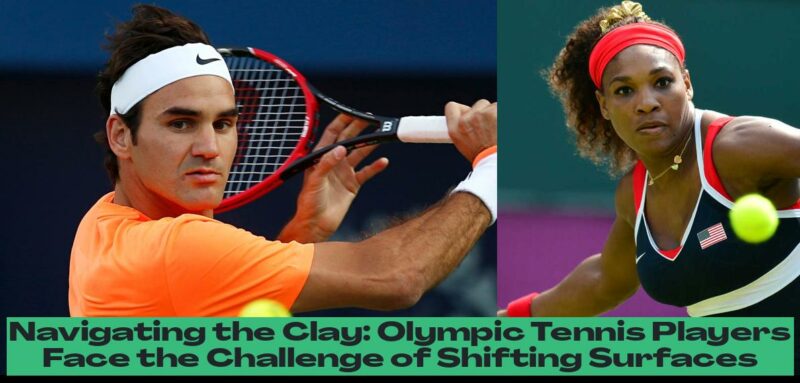The Great Clay Court Comeback: Olympic Tennis Players Navigate the Surface Shift
The world of tennis is a whirlwind of transitions, with players constantly adapting to different surfaces, climates, and playing styles. This year’s Olympic Games in Paris present a unique challenge for tennis players: a return to the red clay courts of Roland Garros just a few weeks after the grass courts of Wimbledon. This sudden shift in surface, a phenomenon not seen in over 30 years, has sparked debate and intrigue among players and fans alike.
The clay courts of Roland Garros, known for their slow pace and high bounce, demand a different style of play compared to the lightning-fast grass courts of Wimbledon. While Wimbledon favors aggressive serves and volleys, Roland Garros rewards patience, consistency, and strategic shot placement. Players who thrive on the grass, with their powerful serves and quick reflexes, might find themselves out of their element on the clay.
- Olympic tennis players face a unique challenge this year with a swift transition from Wimbledon’s grass courts to Roland Garros’ red clay, requiring a significant adjustment in playing style.
- The clay courts of Roland Garros demand patience, consistency, and strategic shot placement, contrasting the aggressive serves and volleys favored on Wimbledon’s grass courts.
- Athletes like Carlos Alcaraz and Elena Rybakina are preparing to shift gears for the Olympic Games in Paris, acknowledging the need for adaptability and a different approach to succeed on the red clay.
- Players who excel on clay have a distinct advantage with the surface change, as their skills in longer rallies and higher bouncing balls can shine on Roland Garros’ courts.
- The sudden switch from grass to clay presents both challenges and opportunities for Olympic tennis players, adding an element of unpredictability and excitement to the competition.
The Red Clay Challenge: Shifting Gears for Olympic Glory
The transition from Wimbledon’s grass to Roland Garros’ clay is a substantial one, demanding a remarkable degree of adaptability from the athletes. Players who have spent weeks fine-tuning their game for the fast-paced grass courts must now adjust their strategies and techniques for a slower, more deliberate approach.
“It’s going to be a big adjustment,” said world number one Carlos Alcaraz, a player who has excelled on both surfaces. “I played a lot of clay court tennis before Wimbledon, so I’m feeling confident about returning to it. But it’s still a big change, and it’s going to take some time to get used to it again.”
For some players, the shift back to clay might feel more jarring than others. Elena Rybakina, the 2022 Wimbledon champion, has acknowledged the challenge. She is known for her powerful serve and aggressive baseline game, strengths that are more pronounced on grass. Adapting to the slower pace and higher bounce of clay could prove a significant hurdle for her.
“It’s definitely a challenge to switch back to clay after Wimbledon,” Rybakina admitted. “The ball bounces higher on clay, and the rallies are longer. You need more patience and more consistency to win points.”
This sudden change in surfaces also presents a unique opportunity for players who excel on clay. Players like Stefanos Tsitsipas, a known clay court specialist, could see this as a chance to shine. Tsitsipas, a three-time French Open semifinalist, has a proven track record on clay. His ability to control the pace of rallies and move comfortably on the court will be a significant advantage in Paris.
Olympic Tennis on Red Clay: A Historical First
The decision to hold the Olympic tennis competition on red clay is a departure from the tradition of using hard courts, the standard surface for most of the world’s major tournaments. This shift to clay will not only impact the style of play but also the overall atmosphere of the event. While the grass courts of Wimbledon are known for their classic charm and elegance, the red clay of Roland Garros brings a sense of grit and determination.
“It’s a great decision to hold the Olympic tennis competition on clay,” said French tennis legend Yannick Noah. “It’s a surface that is very special to us. It’s a surface that demands a lot from the players, but it also rewards them with a lot of glory.”
The return to clay for the Olympic Games is a significant historical shift. It marks a return to the surface that was used for the inaugural Olympic tennis tournament in 1896. The last time the Olympics featured clay courts was in 1992 in Barcelona.
The Clay Court Advantage: Strategies for Success
The key to success on clay lies in adapting to its unique characteristics. Players need to develop strategies that capitalize on the slower pace of the game and the higher bounce of the ball. Here are some key tips for adapting to the red clay:
-
Embrace the Rally: Clay courts are known for their long rallies. Players must be patient and consistent, willing to engage in extended exchanges.
-
Control the Pace: The slower surface gives players more time to set up shots. Players should focus on controlling the pace of the rally, dictating the tempo and keeping their opponent off balance.
-
Precision and Placement: Accurate shot placement is crucial on clay. Players need to focus on hitting precise shots, aiming for the corners of the court or forcing their opponents to make challenging shots.
-
Strategic Movement: Clay courts are known for their slow surfaces, and players need to be adaptable in their movement.
-
Mental Toughness: Clay court tennis demands a high level of mental toughness. The long rallies and the slower pace can be mentally draining. Players need to stay focused and maintain their composure throughout the match.
The Olympic Spotlight: A Chance to Shine
The Olympic Games present a unique opportunity for tennis players to compete on a global stage. With the return of the red clay to the Olympic tennis competition, the stage is set for a captivating display of athleticism, skill, and strategy. The world will be watching as these athletes battle for Olympic glory on the iconic courts of Roland Garros.
The transition from Wimbledon’s grass to Roland Garros’ clay is a testament to the constant adaptation and evolution that defines the world of tennis. This year’s Olympic Games, with their unique focus on clay, promise to be a thrilling event, showcasing the athletic prowess and strategic brilliance of the world’s best tennis players.









